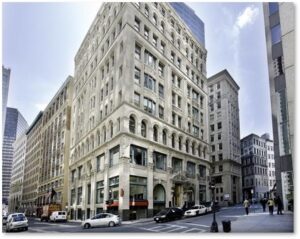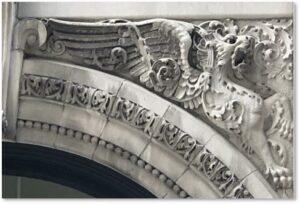When I wrote the post on Milk Street, I focused on its history rather than the buildings that currently line it. The Great Fire of 1872, truncated that history when it destroyed Milk Street’s structures from one end to the other.
That does not mean, however, that some of the buildings that rose from the ashes lack architectural or artistic interest. You just have to stop and look around to see them. One that stopped me is the International Trust Company building at 45 Milk Street.
The International Trust Company Building
 The International Trust Company was founded in 1879. Its growth reflected the expansion of banking and finance in the late nineteenth-century Boston. It grew to become one of the largest trust companies in New England in the early 20th century.
The International Trust Company was founded in 1879. Its growth reflected the expansion of banking and finance in the late nineteenth-century Boston. It grew to become one of the largest trust companies in New England in the early 20th century.
This nine-story building, erected in 1893, served as the original home office of the renowned Old Colony Trust Company division of the Bank of Boston. Prolific Boston architect William G. Preston designed it in the Beaux Arts architectural style. His creation reminds us what office buildings once looked like when they incorporated classical architectural elements. The structure’s design and decoration contrast with the curtain-walled, glassed-in, and uniformly boring modern office towers of the Financial District around it, as well as the Seaport.
Unlike those buildings, which have a repetitive and bland appearance from sidewalk to roof, the International Trust Company Building’s design delineates clear bottom, middle and top sections.
Classical Architectural Elements
A series of arched windows define the third, seventh, and eighth floors and separate them from the middle floors. Engaged columns divide this middle section into vertical thirds and each side has a three-floor inset bay window that defines vertical strips up the center.
The building’s granite came from the Bedford Stone Quarries Company of Bedford, Indiana. An oolitic limestone, it is homogeneous, equally strong in vertical, diagonal or horizontal sections. This stone was “soft” when it was shipped from the quarry, but with exposure it hardened to a strength of from 10,000 to 12,000 pounds per square inch. The original creamy appearance also whitened with age.
This Bedford granite offers the additional advantage of being very pure, and thus not as affected by decay from burning coal as magnesian limestones. For these reasons, architects used it in multiple buildings around Boston.
The Bachman Carvings
The carvings really interest me, however. I love the decorative elements nineteenth-century architects used in abundance but were abandoned by their twentieth century counterparts.
Architectural carvings by Max Bachman both establish the structure’s base, enliven the façade, and define the entry way. They are complex and detailed, filled with interesting images.
Mr. Bachman used figures of commerce, fidelity, industry and security. The head of Hercules, wearing a lion skin for a helmet, looks down from the center of the arched pediment over the front door. Overflowing cornucopias and acanthus-leaf scrollwork fill the remaining space. Garlands flow inward from medallions at either end.
Classical References
You might think 45 Milk Street had been a hospital because a caduceus decorates the capitals of the Corinthian pilasters that bracket the front door and extend around the sides. A shield above the two front pilasters holds the entwined letters ITC.
And let’s not forget the griffins. Wonderfully carved and detailed, they fill out the spaces atop the window arches on the ground floor. Blank oval medallions surrounded by oak leaves project from the Milk Street corners.
Together, these works of architectural art make the International Trust Company building more ornate and, thus, more visually interesting to any passerby who takes notice.
Max Bachman, Sculptor
So, who was this man who carved such wonderful images for the International Trust Company?
Born in Brunswick, Germany, in 1862, Max Bachman is acknowledged as active as a sculptor in New York City by 1899. We know he was working for over 30 years before that, however, as evidenced by this work. Noted for his portrait busts, Indian heads, and allegorical figures, Mr. Bachman had a successful career. This included a large commission for a number of figures from around the world at the Pulitzer Building (New York World Building) in New York City. (No longer extant.) He died in 1921.
Jewel Box Buildings
The International Trust Company building is one of only a few “jewel-box” buildings in downtown Boston, so called because they are older structures with distinctive architectures that have been well maintained. In 1979, the building was named to the National Register of Historic Places (Building – #79000369).




“Born in Brunswick, Germany, in 1862, Max Bachman is acknowledged as active as a sculptor in New York City by 1899. We know he was working for over 30 years before that, however, as evidenced by this work.”
well if he was 37 in 1899 it does not seem likely that he was “working” over 30 years before — that is under age 7 ??
But its beautify sculpture – just walked by the ITC today and would love to see more of his work, know more about his practice.
Good point.